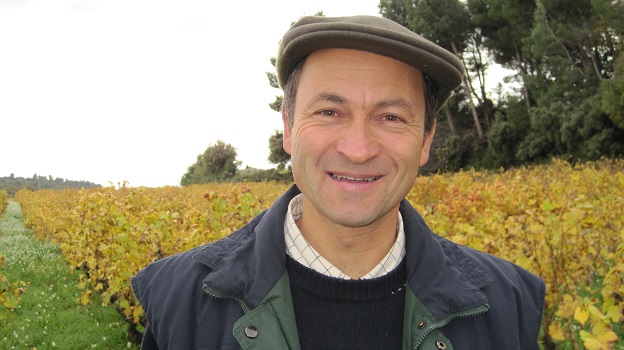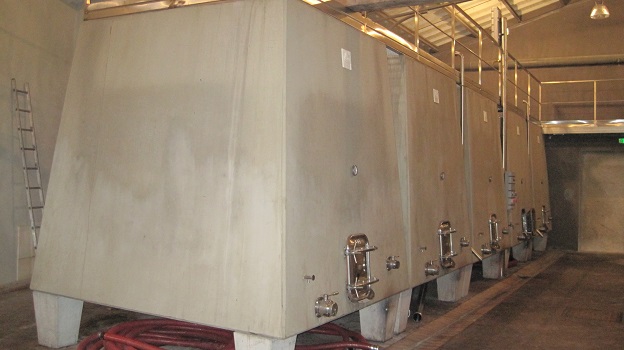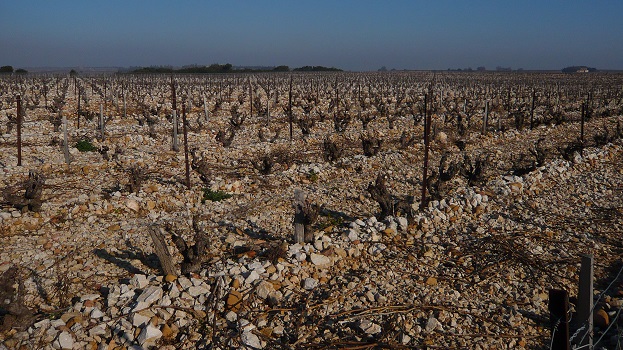Browse using the new Vinous website now. Launch →
Printed by, and for the sole use of . All rights reserved © 2015 Vinous Media
Châteauneuf du Pape: The Lively 2013s and Lush 2012s
Producers in Châteauneuf-du-Pape have been cursed with shorter crops than usual in recent vintages but 2013 took production to a new low. Yields were off by as much as 75% for growers whose vineyards are planted heavily with Grenache, which of course means nearly everybody. So there has been plenty of angst to spread around.

Emmanuel Reyanud in the vines outside Rayas' front door
The 2013 Growing Season and Wines
The culprit in 2013, as in 2012, was a cold spring that delayed the flowering, with temperatures even more frigid than in 2012—so much so that many older vines, mostly Grenache, produced no fruit at all and, in the worst cases, actually died. Temperatures often hovered near freezing into May, which is virtually unprecedented in the region. It was also exceptionally wet through the spring, with total rainfall of 217 millimeters in the March through May period (compared to 165 in 2012, 17 in 2011 and 107 in 2010). For earlier-flowering varieties like Grenache, that’s a perfect storm for disaster, and paltry yields were the result. Fortunately, Mourvèdre and Syrah, which flower later than Grenache, were relatively unscathed.
It was clear by late spring that, short of a miracle, 2013 would have to be an exceptionally late harvest if there was any hope for the fruit to reach maturity. Luckily, a warmer-than-usual July helped accelerate the ripening process, although growers were under no illusions that the season was going to get fully back on track. Fortunately, the weather stabilized and remained clement through the summer, with most estates commencing harvest on or around September 15. The more patient and less risk-averse picked into early November, by which time what Grenache was still hanging on the vines had become fully ripe.

Tronconic cement tanks at Janasse
The best 2013 Châteauneufs
offer an intriguing blend of vivacity (a result of the later ripening season,
which helped to maintain acidity levels) and dark fruit character (because of
the increased reliance on Mourvèdre and Syrah). I suspect that many fans of Châteauneuf-du
Pape will find some of the ‘13s perplexing, as they often show less of the red
fruit character that long-time southern Rhône lovers associate with these
Grenache-dominated bottlings. On the other hand, those who associate this
region’s wines with jammy berry fruit might find the 2013s more to their liking,
as these wines usually exhibit less of the typical raspberry liqueur character that
characterizes ripe vintages like 2009, 2007 and 2003. I believe fans of cooler vintages
like 2008 and 2004 should pay special attention to the ’13s.
Overall, tannin levels in the ‘13s are on the low side, even with higher-than-usual percentages of generally more tannic Syrah and Mourvèdre. Still, I suspect that thanks to the high natural acidity of the wines, most of them will age along a fairly graceful curve without ever really shutting down. This is a vintage of energy and freshness, as nearly all the producers I visited in February emphasized, and such years are often surprisingly ageworthy.
Vines in the northern sector of the appellation
The 2012 Growing Season and Wines
Two thousand twelve, on the other hand, provided the climatic conditions for ampler, more powerful wines with more typical red-fruit personalities and mostly round, harmonious tannins that will allow for early drinking pleasure. Like 2013, 2012 got off to a rough start, with cold weather slowing down the flowering and reducing the potential size of the crop, which ultimately was down by about 40% overall, and nearly 60% in some vineyards. Unlike in 2013, though, the growing season picked up its pace and provided the conditions for steady ripening of the grapes, thanks to a warm—and often hot—summer, some well-timed early August rainfall and drying winds in late summer. The more-or-less-normal harvest began in late August and was mostly wrapped up by the third week of October.
The best ‘12s approach the
quality level of many of the top wines of 2010, in my opinion, but in
comparison to the earlier vintage tannin levels are lower and the quality of
those tannins is more delicate. In many ways, to make a very broad generalization,
the typical 2012 Châteauneuf offers all things to all people: it has sufficient
structure for at least mid-term aging as well as the forward fruit and
harmonious tannins to drink on the young side. As with the 2013s, I wonder how
many 2012s will truly shut down—and, even then, how long their closed stage will
last. My guess would be: not long. The 2012s bear comparison to other forward
vintages like 2009 and even 2007, but the 2012s generally show less weight,
ripeness and power. Those who prefer drinking their Châteauneufs in the bloom
of youth are going to find plenty to like in the 2012s.

Marc Perrin of Beaucastel
A word on prices
As is now the case with bottles from other famous wine regions, the best and most sought-after Châteauneufs command prices that bear little if any relationship to reality, at least on my subjective scale of value. Happily, outside of the upper tier—or perhaps the second tier here—there are myriad values to be found. But the “basic,” or “traditional,” bottlings from even the finest Châteauneuf producers often deliver exceptional price/quality rapport, and in many cases these releases come far closer to the quality of their limited-production high-end siblings than price differentials would suggest. If you want the very best, you’d better be willing to pay up. But in years like 2013 especially, when many conscientious producers opted to blend their most prized juice down into a single bottling, consumers will find some remarkable buying opportunities.
--Josh Raynolds
Show all the wines (sorted by score)
- Arnoux et Fils
- Auguste Bessac
- Bosquet des Papes
- Brotte
- Caves Saint-Pierre
- Cellier des Princes
- Chapelle St. Théodoric
- Château Beauchêne
- Château Cabrières
- Château de Beaucastel
- Château de la Gardine
- Château de la Grande Gardiole
- Château de Manissy
- Château des Fines Roches
- Château de Vaudieu
- Château Fargueirol
- Château Fortia
- Château Gigognan
- Château Jas de Bressy
- Château La Nerthe
- Château Maucoil
- Château Mongin
- Château Mont-Redon
- Château Mont-Thabor
- Château Rayas
- Château Saint-Jean
- Château Saint-Roch-Brunel
- Château Simian
- Château Sixtine
- Christophe Mestre
- Clos de l'Oratoire des Papes
- Clos des Brusquières
- Clos des Papes
- Clos du Calvaire
- Clos du Mont-Olivet
- Clos Saint-Jean
- Clos Saint-Michel
- Cuvée du Vatican
- Delas Frères
- Domaine Albin Jacumin
- Domaine Berthet-Rayne
- Domaine Bois de Boursan
- Domaine Brunely
- Domaine Chante Cigale
- Domaine Chante-Perdrix
- Domaine Charvin
- Domaine Comte de Lauze
- Domaine de Beaurenard
- Domaine de Châteaumar
- Domaine de Cristia
- Domaine de Ferrand
- Domaine de Fontavin
- Domaine de la Biscarelle
- Domaine de la Charbonnière
- Domaine de la Côte de l'Ange
- Domaine de la Croze-Granier
- Domaine de la Janasse
- Domaine de la Mordorée
- Domaine de L'Arnesque
- Domaine de la Roncière
- Domaine de la Solitude
- Domaine de la Vieille Julienne
- Domaine de l'Harmas
- Domaine de Marcoux
- Domaine de Mourchon
- Domaine de Nalys
- Domaine de Panisse
- Domaine de Pignan
- Domaine des 3 Cellier
- Domaine de Saint Siffrein
- Domaine des Saumades
- Domaine des Sénéchaux
- Domaine de Villeneuve
- Domaine du Banneret
- Domaine du Bois de Saint-Jean
- Domaine Duclaux
- Domaine du Grand Tinel
- Domaine du Pegau
- Domaine du Père Caboche
- Domaine du Père Pape
- Domaine Durieu
- Domaine Duseigneur
- Domaine du Vieux Lazaret
- Domaine du Vieux Télégraphe
- Domaine Font de Michelle
- Domaine Galévan
- Domaine Giraud
- Domaine Grand Veneur
- Domaine Henri Bonneau
- Domaine Isabel Ferrando
- Domaine Jean Royer
- Domaine Jérôme Gradassi
- Domaine Julien Masquin
- Domaine Juliette Avril
- Domaine La Barroche
- Domaine L'Abbé Dîne
- Domaine La Boutinière
- Domaine La Consonnière
- Domaine Lafond Roc-Epine
- Domaine La Mereuille
- Domaine La Millière
- Domaine La Roquète
- Domaine Le Mourre
- Domaine Le Pointu
- Domaine Les Semelles de Vent
- Domaine Mas Saint-Louis
- Domaine Mathieu
- Domaine Olivier Hillaire
- Domaine Patrice Magni
- Domaine Paul Autard
- Domaine Pierre Usseglio
- Domaine Pontifical
- Domaine Porte Rouge
- Domaine Raymond Usseglio & Fils
- Domaine Roche-Audran
- Domaine Roger Perrin
- Domaine Roger Sabon
- Domaine Saint-Paul
- Domaine Saint-Préfert
- Domaine Santa Duc
- Domaine Serguier
- Domaine Tourbillon
- Domaine Tour Saint-Michel
- Eddie Féraud
- E. Guigal
- Éric Texier
- Famille Perrin
- Famille Tardieu (Tardieu-Laurent)
- Féraud-Brunel
- Ferraton Père & Fils
- Gabriel Meffre
- Georges Lelektsoglou
- Grandes Serres
- La Bastide Saint-Dominique
- La Celestière
- La Crau de Ma Mère
- La Fagotière
- Lavau
- Le Bois Pointu
- Le Clos du Caillou
- Les Cailloux
- Les Granges des Papes
- Les Halos de Jupiter
- Les Trois Couronnes
- Le Vieux Donjon
- Louis Bernard
- Maison Bouachon
- Maison Chapoutier
- Mas de Boislauzon
- Ogier
- Olivier & Lafont
- Olivier Ravoire
- Paul Jaboulet Aîné
- Pierre-Henri Morel
- Pierre Vidal
- Rotem & Mounir Saouma
- Saint-Cosme

